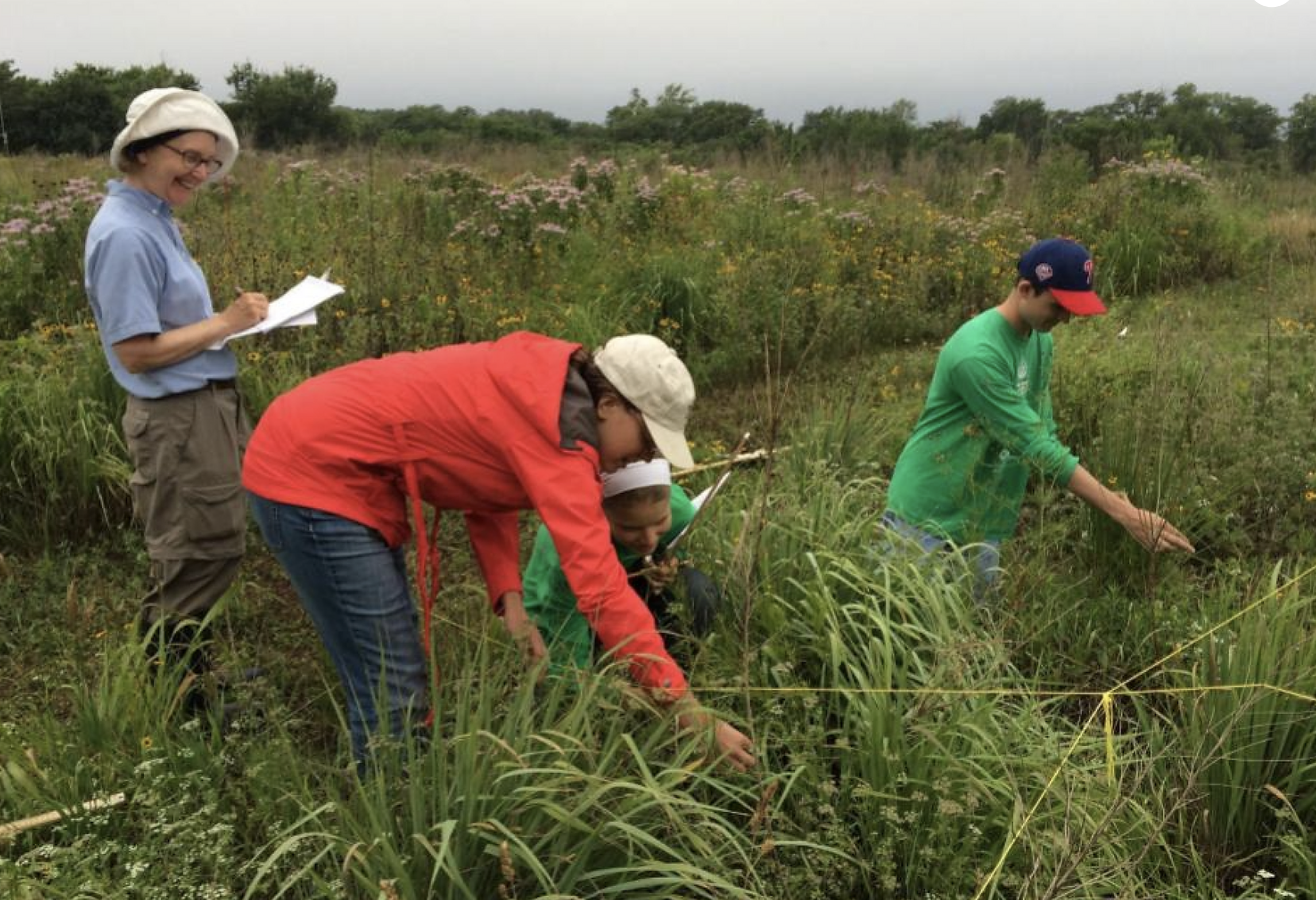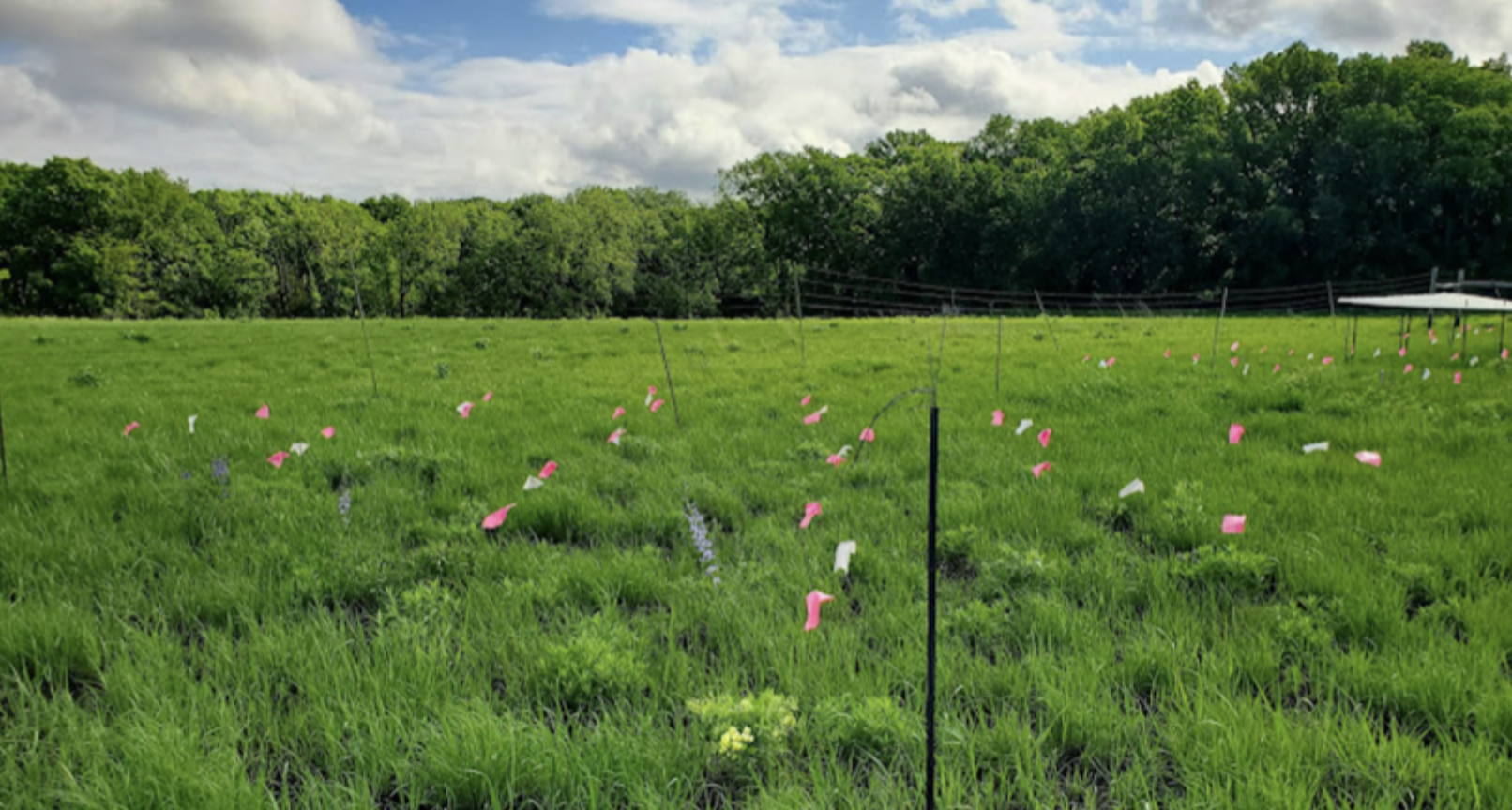Understanding Our Environment

September 2021 Issue
Understanding Our Environment is the internal newsletter for the Kansas Biological Survey & Center for Ecological Research community. Please email biosurvey@ku.edu regarding any errors or omissions.
Photo: View toward main campus and the Kansas River Valley from the Rockefeller Prairie overlook at the KU Field Station.
Our New Name
Approval for our unit’s new name — the Kansas Biological Survey & Center for Ecological Research — came in July from KU Vice Chancellor for Research Simon Atkinson. The news was announced through a story distributed by KU News. Sara Baer, Bio Survey director, said the change was meant to raise the visibility of our primary function as a KU designated research center and our research strength in ecology.
Along with the name change, we’ve also made changes to our social media pages. Our Facebook page and YouTube channel have been renamed “Kansas Bio Survey & Center for Ecological Research,” and a new Twitter page with same name has been created. We’ve retained our existing Twitter account for the KU Field Station.
Friday Ecology Seminars
Our longstanding lunchtime seminar series, begun by Helen Alexander (left in photo, below, from an earlier time), retiring professor of ecology and evolutionary biology (EEB) and longtime member of the KU Field Station Executive Committee, resumes this semester. Ben Sikes, associate scientist and associate professor of EEB, has officially taken the reins as coordinator. See the Fall 2021 schedule, and get in touch with Ben if you’d like to give a talk or suggest a speaker. We will continue to record talks and post them on our YouTube channel.

Comings and Goings
We welcome new students as the fall semester begins. Lola Klamm and Annalise Guthrie are graduate students in the Billings Lab (Sharon Billings, senior scientist and Dean’s Professor of EEB). Lola will be working as a master’s student on the three-year USDA National Institute of Food and Agriculture-funded project on soil research announced earlier this year. Annalise, who has been a lab member as an NIH-funded PREP student and through the Haskell Environmental Research Studies (HERS) Summer Internship, will continue work, as a student in the doctoral program, on the NSF EPSCoR MAPS (Microbiomes of Aquatic, Plant, and Soil Systems across Kansas) project with NSF Graduate Research Fellowships Program (GRFP) funding.
Yufan Zhou comes from Purdue University and will be in rotation with Maggie Wagner, Ben Sikes and Jim Bever; he will be working on a project related to host impacts of microbiome community assembly. Maggie is an assistant scientist and an assistant professor of EEB. Jim is a senior scientist and Foundation Distinguished Professor of EEB.
Sarah Flynn is a new NSF graduate research fellow in the Burgin Lab (Amy Burgin, associate scientist and associate professor of EEB),and Zach Storc joins the Baer Ecology Lab (Sara Baer) as a graduate student.
We join the Bever/Schultz Lab (Jim Bever and Peggy Schultz, faculty member in the Environmental Studies Program) in welcoming Justin Van Goor, postdoctoral researcher, who will begin a project investigating nematode-mediated suppressions of fungal pathogens associated with agricultural plants and their undomesticated relatives.
We send our best wishes with Aaron Baumgardener, research technician in the Bever/Schultz Lab, who will begin a position as a resource manager with the Catawba Nation in South Carolina.
Kayla Clouse, graduate student in the Wagner Lab (Maggie Wagner), has passed her oral comprehensive exam and has advanced to Ph.D. candidacy. Congratulations!
Grants
Five scientists from our center are part of a multi-institutional team awarded a five-year, $12.5 million NSF grant focused on the restoration of native prairie and agricultural ecosystems, with more than $3 million coming to KU. Collaborators include eight institutions and 26 scientists and educators. KU researchers will focus on native prairie ecosystems and polycultures using the trademarked perennial grain Kernza that is under development with The Land Institute in Salina. The KU researchers are Jim Bever, Peggy Schultz, Maggie Wagner, Ben Sikes and Tom McKenna (assistant research professor). The lead institution is the Donald Danforth Plant Science Center in St. Louis.
Sharon Billings has received funding through NSF’s Frontier Research in Earth Sciences for a new project, “Collaborative Research: How roots, regolith, rock and climate interact over decades to centuries — to R3-C Frontier.” The project team, which will receive nearly $3 million, will investigate the top-down (vegetation, microbes) vs. bottom-up (bedrock, minerology) controls on soil structure and how that in turn drives elemental fluxes at the pedon, catchment and continental scales. Partners include Oregon State University, Colorado School of Mines, Kansas State University, Boise State University, Penn State University, and the University of California, Riverside. The project runs through 2025, with $432,000 coming to KU.
The Bever/Schultz Lab is receiving supplementary support in NSF funding for the Dimensions of Biodiversity project, which will support the work of Alex Hoffpauir, and from another NSF grant for Madison Tunnell, who are working as postbaccalaureate scholars in preparation for their applications to graduate school. In addition, Theo Michaels, doctoral student, has supplemental funding, to begin in January, through the NSF INTERN program to work with The Nature Conservancy Kansas to examine community-based land management efforts specific to prescribed burns in Anderson County.
Rondy Malik, postdoctoral researcher in the Bever/Schultz Lab, has received a three-year, $160,000 National Institutes of Health IRACDA (Institutional Research and Academic Career Development Award) fellowship. Roberto De Guzman, KU professor in the Dept. of Molecular Biosciences, is PI on the fellowship grant.
New Research Products
Over the summer, Chen Liang, doctoral student in geography working with Dana Peterson and Jude Kastens and funded by KansasView (led by Dana as part of the USGS AmericaView program), developed a web app called the Sentinal GreenReport. The app uses Google Earth Engine and Sentinal-2 satellite imagery — which provides 10-meter spatial resolution, much higher than previous platforms — to visualize NDVI (normalized difference vegetation index) and NDVI change over time for any state or territory in the U.S. The app contains four map layers that are also in the MODIS satellite-derived GreenReport, which our KARS program has maintained for more than 20 years. Chen worked with Dana, Jude and Xingong Li, professor of geography and atmospheric science, who has just been named an affiliate of our center. The group is discussing potential applications for the product, including topics related to drought (fire risk, crop health and grassland forage productivity) and disaster response, as well as expanding to global coverage.
Publications
Maggie Wagner’s paper, “Microbe-dependent heterosis in maize,” co-authored by doctoral student Kayla Clouse, was published in the Proceedings of the National Academy of Sciences (PNAS). The research basis for the paper was covered by KU News and highlighted in Science Magazine. In addition, Maggie’s “Tansley Insight” short review paper, “Prioritizing host phenotype to understand microbiome heritability in plants,” was commissioned by New Phytologist and published in July.
Christopher Rogers, associate research professor, has a new paper, “Multilocus phylogenetics of smooth clam shrimps (Branchiopoda, Laevicaudata)” in Zoologica Scripta. The smooth clam shrimp is found worldwide, and one of the major points of the paper is that Palaeogene radiation of these temporary pool shrimp appears to have occurred simultaneously with the radiation of birds, which are the primary dispersal vectors for these shrimp today. Thus, as aquatic birds evolved and migrated, they fed on and spread these shrimp to new temporary pools around the remains of Pangaea, which allowed the shrimp to evolve into new isolated species.
Awards
Ashley Wojciechowski and Katie Eckhoff, doctoral-program students in the Baer Lab, took honors in the Restoration Ecology section student poster competition at the Ecological Society of America conference in early August. Ashley took first place for her poster, “Heterogeneity begets heterogeneity: Increasing soil heterogeneity increases plant diversity and richness” (field site photo below). Katie took second place for her poster, “Persistent decadal differences in plant communities restored under contrasting climate conditions.”

Publicity
A story in the Wichita Eagle — “What are playas and what can they do for Kansas farmers? New study hopes to find out” — which was picked up by the Kansas Rural Water Association in its newsletter, reports on a study by Jude Kastens, associate research professor, and researchers from the Kansas Geological Survey, the University of Waterloo and Minnesota State University-Mankato in Groundwater Management District 1 in western Kansas. The group is studying the interaction between playas and agriculture, with results intended to help farmers decide whether to till through or around these small temporary wetlands. The KRWA reports that there are nearly 22,000 playas in Kansas and that they may play a critical role in recharge of the High Plains Aquifer.
Kelly Kindscher was interviewed by The New York Times for an article titled, “Echinacea isn’t itself anymore,” about native Echinacea varieties and their characteristics that attract pollinators, as well as new varieties cultivated for the garden and which of those might be better choices for supporting pollinators.
A story on blue-green algae in Kansas and water quality testing at Clinton Lake led by Ted Harris, assistant research professor, was covered by KMUW Wichita Public Radio and subsequently by the Lawrence Journal-World: “Climate change is breeding blue-green algae and costing Kansans to fix stinky water.” Project team members are researcher Debbie Baker, graduate student Javier Morales, and undergrads Becca Kessler and Alex Martin.
KU Field Station
Remember that big thunderstorm in mid-August (night of the 12th and morning of the 13th, reported by the Lawrence Journal-World)? Weather data from the KU Field Station served as back-up for the Lawrence Municipal Airport ASOS (Automated Surface Observing Systems) station, which lost all its data when strong winds knocked out power to the airport. The Field Station reported 4.12 inches, so that stood as official National Weather Service rainfall for the City of Lawrence for the 24 hours preceding the report. Daily temperature and precipitation data are recorded as part of the National Weather Service Cooperation Program (COOP) from a station behind the Armitage Center, and the data was ready when it was needed. The Field Station staff also measures precipitation manually as part of the Community Collaborative Rain, Hail & Snow (CoCoRaHS) network. Precipitation data for the Field Station date back to 1986.
Beyond KU
Christopher Rogers is working with Rolling Hills Zoo in Wichita, Kan., that compares a new prototype mosquito trap developed by the USDA to three different standard mosquito traps typically used in arboviral disease monitoring. The traps are run under different conditions and across different habitat types for different mosquito species (there are about 50 in Kansas). Results so far — this is year two — show that what attracts one species may repel another, indicating that different traps may be better suited for different taxa and assessing different mosquito-borne disease threats.
Helen Alexander shares a post she wrote for the Kansas Association for Conservation & Environmental Education (KACEE) for its website blog. She shares her story in “Find your passion in EE: Helen Alexander.”